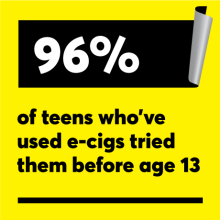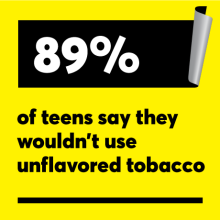Tobacco is Changing: E-Cigarettes
E-cigarettes and vapes continue to threaten Wisconsin youth
E-cigarettes, or “vapes,” are one of the latest evolutions in tobacco products. While traditional cigarette smoking rates have dropped, use of electronic smoking devices has skyrocketed among young people—exposing them to the dangers of nicotine, addiction, and a variety of new health risks. In fact, 15.7% of Wisconsin high school students are current e-cigarette and vape users.
Young people still vape for the flavors
Sweet and trendy flavors like root beer float, cotton candy, and banana split are a big part of why e-cigarettes are so popular. In a recent study, 80 percent of young e-cigarette users said they used e-cigarettes “because they come in flavors I like,” and 95 percent of Wisconsin middle schoolers say they wouldn’t use an unflavored product.
What to look for
E-cigarettes and vapes come in a wide range of shapes and sizes. Some are even designed to hide in plain sight as video games or Bluetooth devices, while tiny oral nicotine pouches tuck into the side of a mouth and are virtually undetectable in use.
Some of the health risks
E-cigarettes are so new, doctors and scientists are still studying the risks—including a 2019 outbreak of vape-related lung injuries and deaths. That means a lot of young adults are using tobacco products that aren’t fully understood. Here are some things we do know:
- E-cigarettes are so new, doctors and scientists are still studying the risks—including a 2019 outbreak of vape-related lung injuries and deaths. That means a lot of young adults are using tobacco products that aren’t fully understood. Here are some things we do know:
- “Tobacco-free” synthetic nicotine products are still very addictive and can often contain more nicotine than plant-based tobacco products.
- Most e-cigarettes contain nicotine, a potent chemical compound that makes cigarettes, chew, and other tobacco products highly addictive.
- An industry leading e-cigarette pod contains as much nicotine as 20 cigarettes.
- Liquid nicotine can contain heavy metals like nickel, tin, and lead.
- Diacetyl, a flavoring found in many e-liquids, has been linked to lung disease.
- Nicotine can harm the parts of the brain that control attention and learning.
- Aerosols contain super fine particles that can irritate the eyes, throat, and lungs.
- Teens who use e-cigarettes are three times as likely to become cigarette smokers.
- No matter how it is delivered, nicotine is addictive.
- E-cigarette devices have been known to explode, causing severe injuries.
Ingesting the nicotine in e-liquids can cause vomiting, confusion, cardiac arrhythmia, coma, and death.
Share what you've learned
Research shows that kids are more likely to avoid risky behaviors when they have an open, trusting relationship with parents and other caregivers, so talk to young people about e-cigarettes and share what you know with parents, teachers, and others.
Tell the young people you know that:
- You can quit, and you don’t have to do it alone. If they’ve already started using e-cigarettes, encourage them to text VAPEFREE to 873373 for free help to quit. You can also start the Live Vape Free online course to receive tools to help you support them through their quit journey.
- If you think everybody’s vaping, you’re wrong. E-cigarette use remains high, but young people often over-estimate just how popular tobacco use is among their peers. Vape shops, ads, and “cloud chasing” videos (usually posted by e-cig users doing vapor cloud tricks), can encourage kids to believe every middle and high schooler is vaping, but the fact is that four out of five Wisconsin teens aren’t using e-cigarettes. Remind your child that most Wisconsin teens choose to live tobacco free.
- Sweet flavors don’t make e-cigarettes safe. Candy and fruit flavors can give the impression that single-use vapes and liquid nicotine are a safe alternative to conventional cigarettes. But e-cigarette users are still at risk for some serious health effects, including addiction, exposure to harmful chemicals and aerosol particulates, and damage to the parts of the brain that control attention and learning.
- Nobody knows all the damage e-cigarettes can do. These new electronic tobacco products are so new, science hasn’t had enough time to study all of the health risks, or understand what long-term use can do to your body. Until they do, vapers are taking a big gamble with an addictive, potentially deadly product.
- Liquid nicotine isn’t just “flavored water.” It’s dangerous. It’s natural to believe a product that’s sold in stores must be safe, but liquid nicotine can be potentially poisonous. In children, nicotine poisoning can occur with exposure to as little as 1 ml (about 20 drops) of 36 mg/mL liquid nicotine.
- E-cigarettes can be a stepping stone to addiction. Teens who use e-cigarettes are three times as likely to become cigarette smokers, and the nicotine in e-cigarettes interferes with healthy brain development—helping to form pathways of addiction in the brain that could lead to the use of other drugs.
Resources
You can also learn more by selecting the following links:
- What is Synthetic Nicotine?
- Know the Risks: E-Cigarettes & Young People
- 2023 Wisconsin Youth Risk Behavior Survey Summary
- Particulate Matter Pollution
- Association of E-Cigarette Vaping and Progression to Heavier Patterns of Cigarette Smoking
- Electronic Cigarette Exposure: Calls to Wisconsin Poison Control Centers, 2010-2015
- Why You Should Talk to Your Kid About Drugs and Alcohol
More products, more risks
Tobacco keeps changing. Learn more about the other addictive tobacco products that are endangering the health of Wisconsin’s youth.
Support required e-cigarette retailer licensing
Unlike other tobacco retailers in Wisconsin, e-cigarette retailers don’t need a license to sell electronic smoking devices and accessories, and that makes it tougher to prevent illegal sales and underage tobacco use. Find out how you can support comprehensive tobacco policies for a healthier state and take action in your own community.
Take the next step
Knowledge is power.
Find out how the tobacco industry creates, packages, and markets its dangerous products to hook young people in your community.















